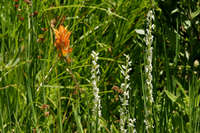Plants 11-130 cm or more. Leaves few-several, ascending to recurved-spreading, scattered along stem, gradually reduced to bracts distally; blade linear, linear-lanceolate, oblong, or oblanceolate, 3.5-32 × 0.3-7 cm. Spikes very lax to very dense. Flowers resupinate, rather showy, conspicuous, white; lateral sepals spreading to reflexed; petals ovate- to linear-lance-falcate, margins entire; lip descending or apex adhering to dorsal sepal and petal apices, linear-lanceolate to lanceolate, without basal thickening, 4-11 × 2-5 mm, base slightly rounded-dilated to orbiculate, rarely rhombic, margins entire; rostellum lobes parallel to slightly divergent, directed downward, very small, obscure, rounded; pollinaria straight; pollinia remaining enclosed in anther sacs; ovary rather slender to stout, 5-15 mm. 2n = 42.
An intense clove scent distinguishes Platanthera dilatata from related species across most of its range, but in the far northwest a more complex blend of spicy fragrances predominates.
Perennial herb 11 - 130 cm tall
Stem: single, erect, very straight, slender to stout, green, hairless, leafy.
Leaves: four to six, alternate, erect to ascending, stalkless, sheathing, dark green, hairless, non-toothed, 3.5 - 30 cm long, 0.5 - 7 cm wide, linear to narrow lance-shaped, gradually reduced to bracts upward.
Inflorescence: a single, erect, stiff, terminal, hairless, usually dense, elongate, spike-like cluster of twelve to eighty stalkless flowers with each flower tightly subtended by an erect, 0.8 - 1.1 cm long, 2 mm wide, lance-shaped bract.
Flowers: strongly fragrant (aroma of cloves), conspicuous, somewhat showy, white, hairless, over 2 cm diameter, bilaterally symmetric with spreading lateral sepals, and center sepal and lateral petals closely positioned above lip petal, which has base modified into a nectar spur. The reproductive parts of stamens, stigma and style are fused into a column above the 0.5 - 1.5 cm long inferior ovary.
Sepals: three, petal-like, white, hairless, non-toothed, with two elliptic to lance-shaped, 4 - 9 mm long, 1 - 2 mm wide lateral sepals spreading or reflexed on either side of lip petal. The central, uppermost sepal, which is typically 3 - 7 mm long, 3 - 4 mm wide, and egg-shaped with a blunt tip that curves downward, is positioned very closely to the lateral petals, which together extend forward to form a hood over the column and above the lip petal.
Fruit: several, stalkless, ellipsoid to cylindric capsules.
Roots: fleshy, thickened near base.
Lateral petals: two, white, extended forward with tips curved inward, flanking central sepal, hairless, non-toothed, 0.4 - 0.9 cm long, 1 - 4 mm wide, linear to widely lance-shaped.
Lip petal: one, central, lowermost, descending, white, non-toothed, hairless, 0.5 - 1 cm long, 2 - 6 mm wide at base, narrowly lance-shaped, but abruptly widened and rounded at base below middle. The very base of the lip petal is modified into a 0.5 - 1 cm long (about same length as lip, rarely longer), non-tapering, slenderly cylindric to slightly club-shaped spur. After pollination, lip petal moves to forward-pointing position or curves upward with tip touching hood of lateral petals and central sepal.
Similar species: In our area we only have the typical variety of Platanthera dilatata, as described above, but two other varieties occur in western North America: P. dilatata var. albiflora has the spur shorter than the lip petal and more club-shaped or even somewhat head-shaped at the end; and P. dilatata var. leucostachys has the spur much longer than the lip, commonly one and a half times or more the lip length. In our area, P. dilatata is very similar to P. aquilonis and P. huronensis, but the former differs mostly by having more yellowish green flowers, a tight and more closed hood, a shorter lip that does not abruptly widen at the base, a shorter spur (only to 0.5 cm), and differences in the anther placement and specifics of the pollinia since it is self-fertilizing. Platanthera huronensis differs by being a bit more robust, having slightly wider leaves, a lighter and less intense fragrance, a shorter inflorescence, a larger and taller open hood, a more whitish green lip that typically does not have a pronounced widened base, and the spur is usually slenderly tapered to the end. However, these three species can be very difficult to distinguish, especially in dried herbarium specimens. In general, P. dilatata superficially looks like a Spiranthes but members of that genus lack obvious stem leaves, usually only having large basal leaves and small sheathing bracts along the stem, the flowers do not have spurs, and the flowers are usually arranged in a spiral orientation along the inflorescence, though some are so tightly arranged the spiral aspect is difficult to discern.
Flowering: May to August
Habitat and ecology: Very rare, typically in sun and on marly or wet calcareous sand, mainly in calcareous fens, but also in open marly clearings or meadows, and other springy seeps with a cold water source.
Occurence in the Chicago region: native
Notes: Platanthera dilatata is a northern boreal species, and the Chicago Region is at its southern extent in the eastern U.S. It is almost extirpated in Indiana, with only one tiny remnant population still known to exist (Homoya 1993).
Etymology: Platanthera comes from the Greek words platys, meaning flat or broad, and anthera, meaning anther, which refers to the wide anther of the genus. Dilatata means broadened or dilated, which refers to the distinct widened base of the lip petal.
Author: The Field Museum










